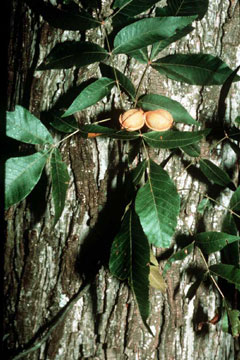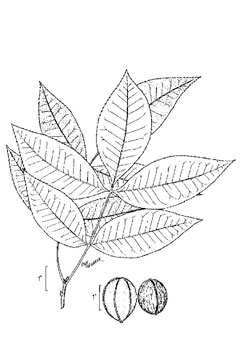 |
|
USDA-NRCS PLANTS Database |
 |
| USDA-NRCS PLANTS Database / USDA NRCS. Wetland flora: Field office illustrated guide to plant species. USDA Natural Resources Conservation Service. |
Translate this page:
Summary
Physical Characteristics

 Carya myristiciformis is a deciduous Tree growing to 30 m (98ft 5in) at a slow rate.
Carya myristiciformis is a deciduous Tree growing to 30 m (98ft 5in) at a slow rate.
See above for USDA hardiness. It is hardy to UK zone 9. It is in leaf from June to October, in flower from April to May. The species is monoecious (individual flowers are either male or female, but both sexes can be found on the same plant) and is pollinated by Wind. The plant is self-fertile.
Suitable for: light (sandy), medium (loamy) and heavy (clay) soils. Suitable pH: mildly acid, neutral and basic (mildly alkaline) soils. It cannot grow in the shade. It prefers moist soil.
UK Hardiness Map
US Hardiness Map
Synonyms
Plant Habitats
Woodland Garden Canopy;
Edible Uses
Edible Parts: Seed
Edible Uses:
Seed - raw or cooked[105, 177, 183]. Sweet, but with a thick shell[1, 229]. The seed is up to 3cm in diameter[229]. The seed ripens in late autumn and, when stored in its shell in a cool place, will keep for at least 6 months[K].
References More on Edible Uses
Medicinal Uses
Plants For A Future can not take any responsibility for any adverse effects from the use of plants. Always seek advice from a professional before using a plant medicinally.
None known
References More on Medicinal Uses
The Bookshop: Edible Plant Books
Our Latest books on Perennial Plants For Food Forests and Permaculture Gardens in paperback or digital formats.

Edible Tropical Plants
Food Forest Plants for Hotter Conditions: 250+ Plants For Tropical Food Forests & Permaculture Gardens.
More

Edible Temperate Plants
Plants for Your Food Forest: 500 Plants for Temperate Food Forests & Permaculture Gardens.
More

More Books
PFAF have eight books available in paperback and digital formats. Browse the shop for more information.
Shop Now
Other Uses
Fuel Wood
Wood - hard, very strong, tough, close grained[82]. A good fuel, burning well with a lot of heat.
Special Uses
References More on Other Uses
Cultivation details
Prefers a deep moisture-retentive loam in a sunny sheltered position, requiring a good summer for best development[1, 63, 137, 200]. Slow growing[200]. Trees are said to only be hardy to zone 9[200], but there is a good specimen growing outdoors at Kew which is in zone 7[137]. Most species in this genus have quite a wide range of distribution and, in order to find trees more suited to this country, seed from the most appropriate provenances should be sought[137]. Most trees growing in Britain at present tend to only produce good seed after hot summers[137]. Trees are self-fertile but larger crops of better quality seeds are produced if cross-pollination takes place[229]. Large seed crops are produced every 2 - 3 years in the wild[229]. Plants are strongly tap-rooted and should be planted in their permanent positions as soon as possible[1, 137]. Sowing in situ would be the best method so long as the seed could be protected from mice[1, 200]. Trees are late coming into leaf (usually late May to June) and lose their leaves early in the autumn (usually in October)[137]. During this time they cast a heavy shade. These factors combine to make the trees eminently suitable for a mixed woodland planting with shrubs and other trees beneath them[137]. Plants in this genus are notably resistant to honey fungus[200].
References Carbon Farming Information and Carbon Sequestration Information
Temperature Converter
Type a value in the Celsius field to convert the value to Fahrenheit:
Fahrenheit:
The PFAF Bookshop
Plants For A Future have a number of books available in paperback and digital form. Book titles include Edible Plants, Edible Perennials, Edible Trees,Edible Shrubs, Woodland Gardening, and Temperate Food Forest Plants. Our new book is Food Forest Plants For Hotter Conditions (Tropical and Sub-Tropical).
Shop Now
Plant Propagation
Seed - requires a period of cold stratification. It is best sown in a cold frame as soon as it is ripe[78]. Stored seed should be kept moist (but not wet) prior to sowing and should be sown in a cold frame as soon as possible[78]. Where possible, sow 1 or 2 seeds only in each deep pot and thin to the best seedling. If you need to transplant the seedlings, then do this as soon as they are large enough to handle, once more using deep pots to accommodate the tap root. Put the plants into their permanent positions as soon as possible, preferably in their first summer, and give them some protection from the cold for at least the first winter[78, K]. Seed can also be sown in situ so long as protection is given from mice etc and the seed is given some protection from cold[200] (a plastic bottle with the top and bottom removed and a wire mesh top fitted to keep the mice out is ideal)
Other Names
If available other names are mentioned here
Native Range
NORTHERN AMERICA: United States (Oklahoma, Alabama (c.), Arkansas, Georgia, Louisiana, Mississippi (c.), North Carolina (southeast), South Carolina, Texas), Mexico (Nuevo León)
Weed Potential
Right plant wrong place. We are currently updating this section.
Please note that a plant may be invasive in one area but may not in your area so it's worth checking.
Conservation Status
IUCN Red List of Threatened Plants Status :

Growth: S = slow M = medium F = fast. Soil: L = light (sandy) M = medium H = heavy (clay). pH: A = acid N = neutral B = basic (alkaline). Shade: F = full shade S = semi-shade N = no shade. Moisture: D = dry M = Moist We = wet Wa = water.
Now available:
Food Forest Plants for Mediterranean Conditions
350+ Perennial Plants For Mediterranean and Drier Food Forests and Permaculture Gardens.
[Paperback and eBook]
This is the third in Plants For A Future's series of plant guides for food forests tailored to
specific climate zones. Following volumes on temperate and tropical ecosystems, this book focuses
on species suited to Mediterranean conditions—regions with hot, dry summers and cool, wet winters,
often facing the added challenge of climate change.
Read More
Expert comment
Author
(F.Michx.)Nutt.
Botanical References
1182200
Links / References
For a list of references used on this page please go here
Readers comment
© 2010, Plants For A Future. Plants For A Future is a charitable company limited by guarantee, registered in England and Wales. Charity No. 1057719, Company No. 3204567.